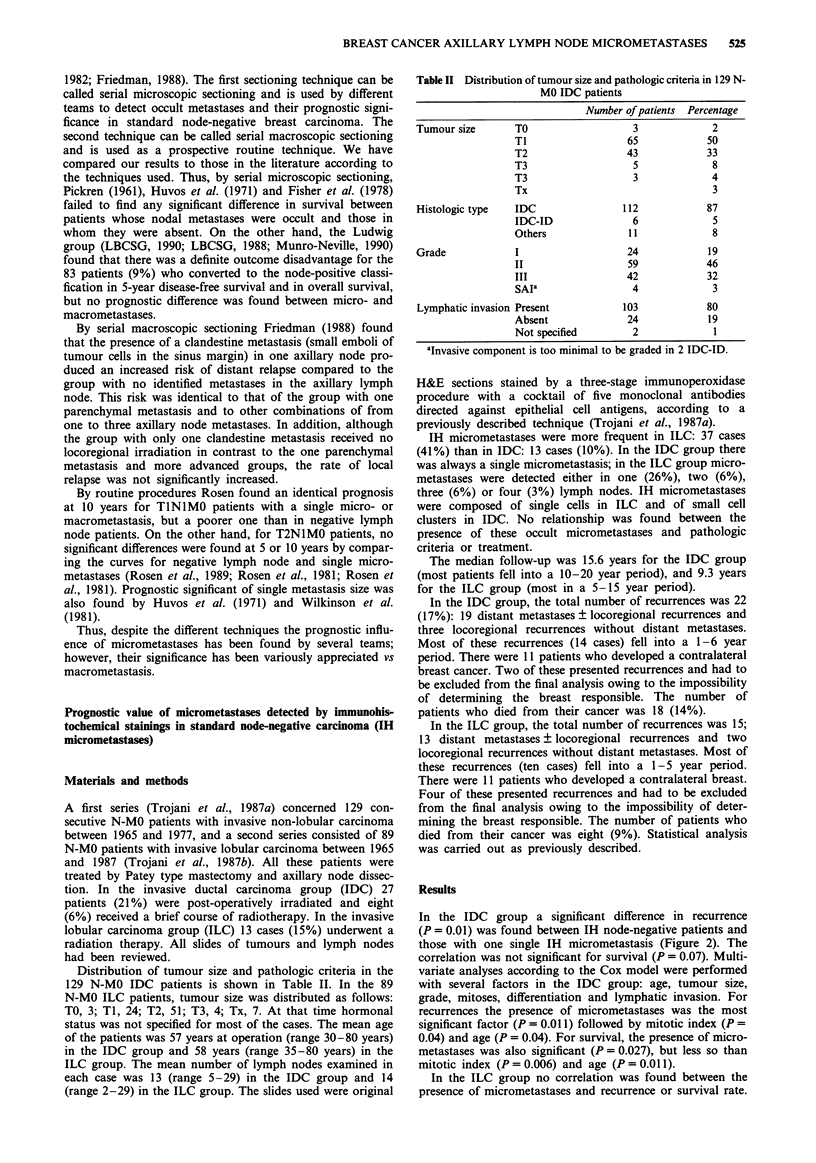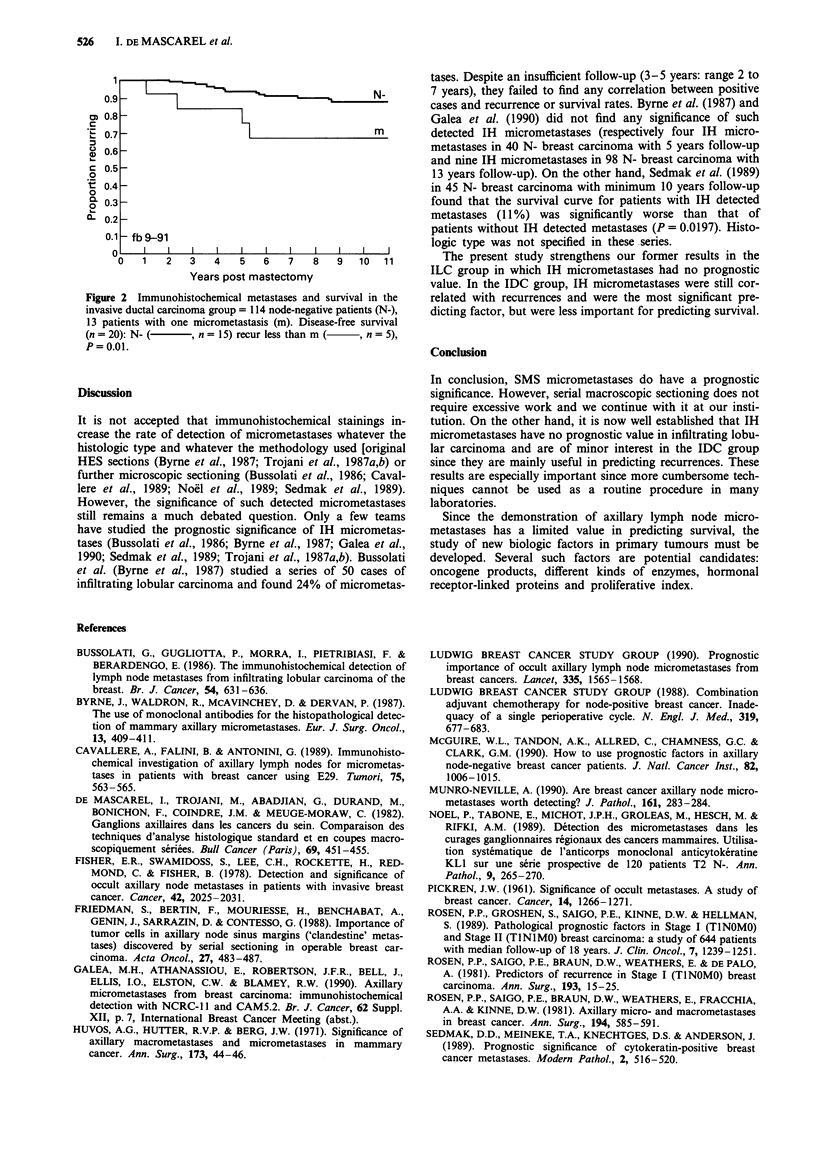Abstract
Special techniques such as serial macroscopic sectioning (SMS) or immunohistochemical staining (IH) improve the detection rate of micrometastases but this detection is of value only if it improves the prediction of recurrence and survival. We first studied the prognosis of 120 patients with a single micrometastasis detected by SMS in a series of 1,680 primary operable breast carcinoma with a median follow-up of 7 years. A significant difference in recurrence (P = 0.005) and in survival (P = 0.0369) was found between node-negative patients and those with one single SMS micrometastasis, but SMS micrometastases were not a predicting factor by multivariate analyses according to the Cox model. We then studied the prognostic significance of patients with a micrometastasis detected by IH in node-negative carcinoma: 37 micrometastases from a series of 89 invasive lobular carcinoma (ILC) and 13 single micrometastases from a series of 129 invasive ductal carcinoma (IDC). In the ILC group, IH micrometastases had no prognostic value (median follow-up: 9.3 years). In the IDC group, IH micrometastases were correlated with recurrences (P = 0.01) and were the most significant predicting factor, but were less correlated with survival (median follow-up: 15.6 years). Three main points emerge from this study: (1) SMS micrometastases have a prognostic significance and macroscopic sectioning is recommended as a routine technique not requiring excessive work. (2) IH micrometastases in infiltrating lobular carcinoma have no prognostic significance. (3) The value of IH is debatable in infiltrating ductal carcinoma, since the technique is of principal use in predicting recurrences. It should therefore be carefully assessed vs other prognostic factors currently under study.
Full text
PDF




Selected References
These references are in PubMed. This may not be the complete list of references from this article.
- Bussolati G., Gugliotta P., Morra I., Pietribiasi F., Berardengo E. The immunohistochemical detection of lymph node metastases from infiltrating lobular carcinoma of the breast. Br J Cancer. 1986 Oct;54(4):631–636. doi: 10.1038/bjc.1986.219. [DOI] [PMC free article] [PubMed] [Google Scholar]
- Byrne J., Waldron R., McAvinchey D., Dervan P. The use of monoclonal antibodies for the histopathological detection of mammary axillary micrometastases. Eur J Surg Oncol. 1987 Oct;13(5):409–411. [PubMed] [Google Scholar]
- Cavaliere A., Falini B., Antonini G. Immunohistochemical investigation of axillary lymph nodes for micrometastases in patients with breast cancer using E29. Tumori. 1989 Dec 31;75(6):563–565. doi: 10.1177/030089168907500609. [DOI] [PubMed] [Google Scholar]
- Fisher E. R., Swamidoss S., Lee C. H., Rockette H., Redmond C., Fisher B. Detection and significance of occult axillary node metastases in patients with invasive breast cancer. Cancer. 1978 Oct;42(4):2025–2031. doi: 10.1002/1097-0142(197810)42:4<2025::aid-cncr2820420452>3.0.co;2-j. [DOI] [PubMed] [Google Scholar]
- Friedman S., Bertin F., Mouriesse H., Benchabat A., Genin J., Sarrazin D., Contesso G. Importance of tumor cells in axillary node sinus margins ('clandestine' metastases) discovered by serial sectioning in operable breast carcinoma. Acta Oncol. 1988;27(5):483–487. doi: 10.3109/02841868809093575. [DOI] [PubMed] [Google Scholar]
- Huvos A. G., Hutter R. V., Berg J. W. Significance of axillary macrometastases and micrometastases in mammary cancer. Ann Surg. 1971 Jan;173(1):44–46. doi: 10.1097/00000658-197101000-00006. [DOI] [PMC free article] [PubMed] [Google Scholar]
- McGuire W. L., Tandon A. K., Allred D. C., Chamness G. C., Clark G. M. How to use prognostic factors in axillary node-negative breast cancer patients. J Natl Cancer Inst. 1990 Jun 20;82(12):1006–1015. doi: 10.1093/jnci/82.12.1006. [DOI] [PubMed] [Google Scholar]
- Neville A. M. Are breast cancer axillary node micrometastases worth detecting? J Pathol. 1990 Aug;161(4):283–284. doi: 10.1002/path.1711610403. [DOI] [PubMed] [Google Scholar]
- Noel P., Tabone E., Michot J. P., Groleas M., Hesch M., Rifki A. M. Détection des micrométastases dans les curages ganglionnaires régionaux des cancers mammaires. Utilisation systématique de l'anticorps monoclonal anticytokératine KL1 sur une série prospective de 120 patients T2 N-. Ann Pathol. 1989;9(4):265–270. [PubMed] [Google Scholar]
- PICKREN J. W. Significance of occult metastases. A study of breast cancer. Cancer. 1961 Nov-Dec;14:1266–1271. doi: 10.1002/1097-0142(196111/12)14:6<1266::aid-cncr2820140617>3.0.co;2-9. [DOI] [PubMed] [Google Scholar]
- Rosen P. P., Groshen S., Saigo P. E., Kinne D. W., Hellman S. Pathological prognostic factors in stage I (T1N0M0) and stage II (T1N1M0) breast carcinoma: a study of 644 patients with median follow-up of 18 years. J Clin Oncol. 1989 Sep;7(9):1239–1251. doi: 10.1200/JCO.1989.7.9.1239. [DOI] [PubMed] [Google Scholar]
- Rosen P. P., Saigo P. E., Braun D. W., Jr, Weathers E., DePalo A. Predictors of recurrence in stage I (T1N0M0) breast carcinoma. Ann Surg. 1981 Jan;193(1):15–25. doi: 10.1097/00000658-198101000-00003. [DOI] [PMC free article] [PubMed] [Google Scholar]
- Rosen P. P., Saigo P. E., Braun D. W., Weathers E., Fracchia A. A., Kinne D. W. Axillary micro- and macrometastases in breast cancer: prognostic significance of tumor size. Ann Surg. 1981 Nov;194(5):585–591. doi: 10.1097/00000658-198111000-00006. [DOI] [PMC free article] [PubMed] [Google Scholar]
- Sedmak D. D., Meineke T. A., Knechtges D. S., Anderson J. Prognostic significance of cytokeratin-positive breast cancer metastases. Mod Pathol. 1989 Sep;2(5):516–520. [PubMed] [Google Scholar]
- Trojani M., de Mascarel I., Coindre J. M., Bonichon F. Micrometastases to axillary lymph nodes from invasive lobular carcinoma of breast: detection by immunohistochemistry and prognostic significance. Br J Cancer. 1987 Dec;56(6):838–839. doi: 10.1038/bjc.1987.301. [DOI] [PMC free article] [PubMed] [Google Scholar]
- Wells C. A., Heryet A., Brochier J., Gatter K. C., Mason D. Y. The immunocytochemical detection of axillary micrometastases in breast cancer. Br J Cancer. 1984 Aug;50(2):193–197. doi: 10.1038/bjc.1984.162. [DOI] [PMC free article] [PubMed] [Google Scholar]
- de Mascarel I., Trojani M., Abadjian G., Durand M., Bonichon F., Coindre J. M., Meuge-Moraw C. Ganglions axillaires dans les cancers du sein. Comparaison des techniques d'analyse histologique standard et en coupes macroscopiquement sériées. Bull Cancer. 1982;69(5):451–455. [PubMed] [Google Scholar]


